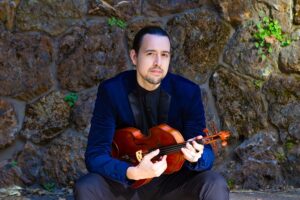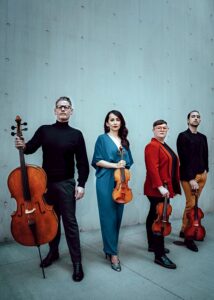Paul Laraia’s viola looks like a rare antique: it’s 16⅜ inches long, with a varnished body the color of amber. Its shoulders are narrow at the top and steeply sloped; the bottom curves inward toward the tailpiece — a highly unusual shape for a modern instrument, most of which look like the standard figure eight.

In fact, Laraia’s viola is only 16 years old. It was made in 2009 by Japanese luthier Hiroshi Iizuka in the viola d’amore style: a languid shape that brings to mind the melting objects of Salvador Dalí.
“Iizuka found his voice in making violas,” says Laraia. The shape, though beautiful, has more to do with acoustics than aesthetics. Laraia, the violist of the Catalyst Quartet, bought the instrument in 2016, enchanted by its warm, horn-like sound.
On Friday, Aug. 8, as part of the Cape Cod Chamber Music Festival, the quartet will perform at the First Congregational Church of Wellfleet. The program is titled “Against All Odds.”
The quartet — Laraia, violinists Abi Fayette and Karla Donehew Perez, and cellist Karlos Rodriguez — was formed 15 years ago by the Sphinx Organization, which is dedicated to fostering diversity in classical music. Laraia has been the Catalyst’s violist for 13 years. The members share a reverence for collaboration: their mission statement is a call for unity. When they play, “Individual voices come together in conversation,” says Laraia. “Nobody’s truth is being muted for the greater good; rather, we’re amplifying each other.”
Friday’s concert will open with Toru Takemitsu’s “Autumn Leaves,” an adaptation for string quartet of Joseph Kosma’s “Les Feuilles Mortes.” Next is Jorge Amado’s “Tríptico Cubano”; then Ludwig van Beethoven’s String Quartet No. 15 in A minor, Op. 132.
Each composer was “a maverick” who overcame obstacles, says Laraia. Takemitsu, who was born in Japan, was drafted to fight in World War II at 14; Amado comes from Cuba, where Laraia says there are few resources for classical musicians; and Beethoven, when he wrote his 15th quartet, was recovering from a serious illness — and he was completely deaf.
In every piece on the program, the viola — a largely unsung instrument, compared to the violin and cello — plays an essential role.
While the proportions of full-size violins and cellos are governed by the Fibonacci sequence, designed to house their resonances, violas have no set size. A full-size viola can range from 15 to 17 inches long. “It’s considered acoustically imperfect,” says Laraia. There is no remedy. A “perfect” viola would need to be about 22 inches long to accommodate its range, says Laraia — too big for anyone to hold under the chin. It would need to be played on the lap “like a tiny cello.”
In this way, the viola itself has prevailed against all odds and thrived. “The viola’s unique voice comes from this acoustical imperfection,” says Laraia. “Some violas sound really rich and bathtubby,” he says. “Some sound dark; some sound bright.”
Though the viola has the same four strings as a cello — C, G, D, A — “the cello comes across as a little more heroic, supremely dramatic,” says Laraia. “The more subtle emotional colors,” he says, “are where the viola shines.”

The viola d’amore gained popularity in the Baroque era. The derivation of its name (in Italian, “viola of love”) is unknown, according to the Metropolitan Museum of Art. The first versions of the instrument had six or seven strings, plus sympathetic strings that weren’t bowed but served to enhance resonance.
Iizuka’s modern violas take their shape from their ancestors. The sloped shoulders make shifting up the fingerboard easier, says Laraia. The air volume missing from its lower bouts is replaced in the extended upper bouts. The result: a large instrument released from the requirements of inapplicable mathematics, able to access the earthy depths of its C string and the keening cry of its A string unhindered.
Every composer on the program recognized the viola’s intrinsic power, says Laraia. In Takemitsu’s “Autumn Leaves,” the viola takes the lead with a long, sultry, melodic phrase, “like a saxophone or a great jazz singer,” Laraia says. In Amado’s “Tríptico Cubano,” a brilliant, jostling, modern piece, the violin and viola exploit their contrasting voices. While the cello’s tone is very different, violin and viola “are like two sides of the same coin,” he says. The violin flies; the viola offers a place to land.
Laraia grew up in Washington Township, N.J. and now lives in New York City. He says he’s “almost a purebred violist.” Originally, he wanted to play the cello, but his mother told him to pick something smaller. For three years, beginning at nine, he played the violin but never learned how to read treble clef. In sixth grade, in order to join the school orchestra, he switched to the viola, learned alto clef, and fell in love.
His public elementary school had a good music program. He still remembers the names of his music teachers: “Shoutout to Norma Meyer,” he says, “and Judy Barnett.” Meyer is a pianist; Barnett plays the viola.
Laraia likes to remind people of a fact about most of the “greats” of classical music: “Mozart, Beethoven, Mendelssohn, Schubert, Dvorak — they were all legit viola players,” he says. When Beethoven, also a brilliant pianist, played his own string quartets, says Laraia, he would play the viola part.
“Beethoven’s music has proved, over and over, that he was all about breaking the limitations of art,” says Laraia. “Starting back in his Opus 18s, the viola had some of the most adventurous parts.”
The third movement of the String Quartet No. 15, Molto Adagio — Andante, which Beethoven called “song of thanksgiving of a convalescent to the Deity,” is the most famous of its five movements. Beethoven was thankful to have survived an intestinal illness that nearly killed him. The Molto Adagio sections, interrupted by the more cheerful Andante ones, are vulnerable and reverent.
As the quartet wanders through suspension and resolution, the viola’s voice takes on an adhesive quality: bridging the gap with its indeterminate timbre between the round, solemn tone of the cello and the thin, mournful notes of the violins.
“Beethoven writes such complicated music,” says Laraia. “He spells out his secret messages and codes in his motifs; he inverts them and flips them on their heads.
“Every voice is important,” he says, especially those that bring the others into focus. It was the voice of his viola that enthralled him when he first heard it, deep and resounding, like a singer with an engaged diaphragm: perfectly imperfect.
“The true soul of all of us who devote ourselves to viola is the idea of unity,” says Laraia. “We have to be so nimble, then we have to be thick. We have to project, we have to blend, we have to be quiet. If we’re doing our job really well, it makes everybody else sound better.”
Instrumental
The event: Catalyst Quartet plays selections from “Against All Odds”
The time: Friday, Aug. 8, 5:30 p.m.
The place: First Congregational Church of Wellfleet, 200 Main St.
The cost: General admission $40; students $20; children under 14 free at capecodchambermusic.org
